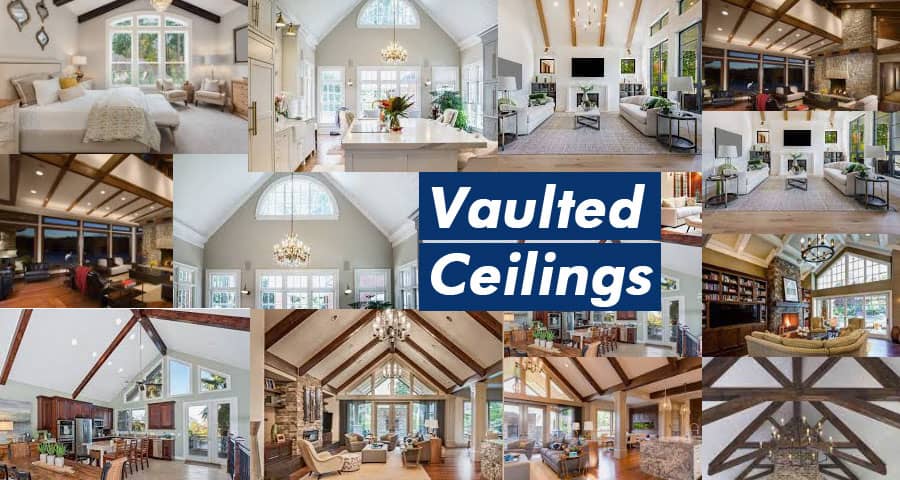Understanding Vaulted Ceilings: An Architectural Marvel

Vaulted ceilings, often hailed as architectural masterpieces, add an unparalleled sense of space, grandeur, and airiness to any room. Stemming from ancient architectural traditions, vaulted ceilings have stood the test of time, evolving into various forms and styles, each exuding its own unique charm and character.
Types of Vaulted Ceilings
- Barrel Vault: The barrel vault, also known as a tunnel vault or wagon vault, is characterized by its semi-cylindrical shape resembling the interior of a tunnel or a barrel. This type of vaulted ceiling offers a smooth, continuous surface, creating a sense of elongation and depth within the space.
- Groin Vault: A groin vault, constructed by intersecting two barrel vaults at right angles, forms a distinctively ribbed appearance. This structural configuration not only enhances the aesthetic appeal but also provides added strength and stability to the ceiling.
- Dome Vault: Dome vaults, reminiscent of the iconic domes adorning historic landmarks, feature a hemispherical or partially spherical shape. Offering a striking visual impact, dome vaults imbue spaces with a sense of grandeur and timelessness, making them a popular choice in architectural design.
- Ribbed Vault: Ribbed vaults, characterized by a series of intersecting ribs, create a visually captivating pattern that accentuates the ceiling's contours. This architectural element adds depth and texture to the space while reinforcing structural integrity.
Advantages of Vaulted Ceilings
Vaulted ceilings offer a plethora of benefits, both aesthetic and functional, making them a coveted feature in residential and commercial spaces alike.
- Increased Sense of Space: By raising the ceiling height, vaulted ceilings create an illusion of spaciousness, making rooms feel larger and more open. This enhanced sense of space contributes to a more welcoming and inviting environment, ideal for both living areas and public spaces.
- Improved Natural Light: The soaring height of vaulted ceilings allows for ample natural light to penetrate the interior, illuminating the space and reducing the need for artificial lighting during daylight hours. This not only enhances the ambiance but also promotes energy efficiency and cost savings.
- Architectural Elegance: Vaulted ceilings serve as focal points in architectural design, adding a touch of elegance and sophistication to any interior setting. Whether adorned with intricate detailing or left unembellished for a minimalist aesthetic, vaulted ceilings exude timeless charm and visual appeal.
- Enhanced Ventilation: The elevated height of vaulted ceilings facilitates improved air circulation and ventilation, creating a more comfortable and breathable indoor environment. This natural ventilation system helps regulate temperature levels and promotes airflow, ensuring optimal comfort year-round.
Incorporating Vaulted Ceilings into Interior Design
- Embrace Natural Materials: When designing a space with vaulted ceilings, opt for natural materials such as wood, stone, or exposed brick to complement the architectural elements. These organic textures add warmth and authenticity to the interior while highlighting the beauty of the vaulted ceiling.
- Strategic Lighting Design: Harness the natural light streaming through the vaulted ceiling by strategically placing windows, skylights, or clerestory openings to maximize illumination. Supplement natural lighting with ambient, task, and accent lighting fixtures to create a layered lighting scheme that accentuates the architectural features.
- Scale and Proportion: Consider the scale and proportion of the space when designing vaulted ceilings to ensure harmony and balance within the interior. Avoid overpowering smaller rooms with excessively high ceilings, opting instead for proportionate heights that enhance the overall aesthetics and functionality of the space.
- Decorative Elements: Personalize the space by incorporating decorative elements such as chandeliers, pendant lights, or ceiling fans that complement the vaulted ceiling's design. Select fixtures that accentuate the height and volume of the space while adding visual interest and character to the room.
Conclusion
Vaulted ceilings epitomize the marriage of form and function, elevating the architectural landscape with their timeless elegance and practical benefits. Whether adorning historic cathedrals or modern residences, these architectural marvels continue to captivate the imagination and inspire awe with their unparalleled beauty and craftsmanship.
